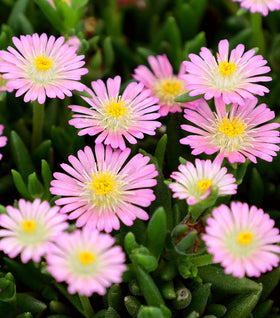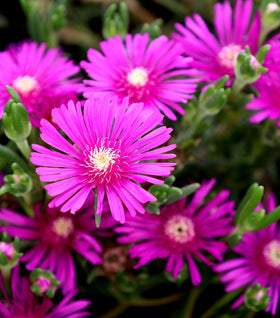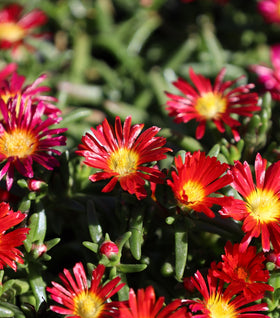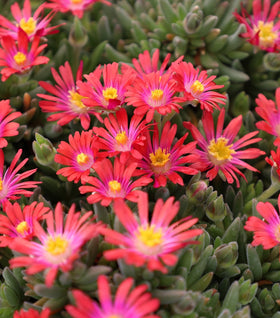Delosperma 'Ice Plants' for Sale Online
Delosperma 'Ice Plants' are a beautiful choice for those pesky dry areas of any landscape because they are extremely drought-resistant. Ice Plants come in a wide variety of colors that will add a pop of vibrancy to any garden. They make for a wonderful rock garden plant and can even be tucked into stone walls. These perennials reach up to 2 feet tall and have a wide-spreading habit. Don't have a garden? No worries! They also do very well in hanging baskets and free-standing pots.
Ice plants grow best in hardiness zones 5-9 and bloom for most of the summer and fall. Their foliage is evergreen making them a great year-round ground cover. Don't worry if you notice some dieback of foliage in the winter, they will spring back up in a few short months.
Types of Ice Plants
Native to South Africa, this drought-tolerant flower adds a splash of color to every garden it is planted in. This perennial gets its name, Ice Plant, not because it is cold hardy, but rather because the flower's leaves shimmer as if they were covered in frost or ice. Grown best in hardiness zones 5 through 9 these flowers thrive when planted in the driest area of a landscape.
Garden Goods Direct offers several varieties of drought-tolerant Ice Plants for sale:
- The fire reddish-orange Fire Wonder
- The vibrant purple Cooperi
- The reddish pink-centered Jewel of the Desert Garnet
- The classic white Jewel of the Desert Moonstone
- The lilac purple Jewel of the Desert Rose
How To Care For Ice Plant Perennials
Soil
Ice Plants love to be planted in dry soil with excellent drainage. This plant will not survive under conditions of consistently moist soil. They also will not grow at all in dense clay soils. The more sandy and gravelly the soil, the better for an Ice Plant. Soils rich in nutrients is not a necessity at all when planting. If you have a specific spot that is too dry to ever plant anything, plant your Delosperma here and watch it flourish.
Sun
Ice plants prefer full sun areas of a garden. The full, direct sun allows them to flower immensely. If your perennial does not get enough sunlight they will suffer and tend to get leggy.
Fertilizer
Adding compost or a slow-release fertilizer when planting benefits these plants very much. In the fall, it is best to add another light dose of more compost or fertilizer to feed your plant before the winter months. Delosperma can survive just fine with no feeding whatsoever. Keep in mind that too much feeding can compromise the plant's ability to survive in the winter.
Watering
Ice Plants love dry, very dry soil. When watering, if at all, water sparingly during the growing season. We recommend watering once every two weeks when there are periods of no rainfall. During extremely hot weather, water your plant weekly. Allow your plant to dry out before winter to ensure it does not sit in soil that is too moist during dormancy. If snow cover is common in your area, mulch your perennial with a dry mulch to keep it dry for the winter.
Common Diseases and Pests on Delosperma 'Ice Plants'
Occasionally aphids and mealybugs can cause problems with your ice plants. Keep an eye out for leaf and stem damage as well as sticky, abnormal substances these pests will leave behind. You can treat small infestations by spraying your plants with water to naturally remove these bugs. It is best to simply replace severely infested plants rather than using harsh chemicals that can harm the ecosystem.




